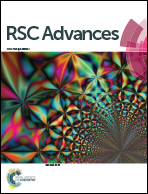Manipulation of multiphase morphology in the reactive blending system OBC/PLA/EGMA†
Abstract
In recent years, biodegradable polymers derived from bioresources have received more and more attention. Making a new type of blend by compounding biodegradable polymer with a petroleum-based polymer is now an important method of preparation for such polymers. A key issue to dominate the quality of a polymer blend is manipulation of multiphase morphology. In this study, a bio-degradable polymer, poly(lactic acid) (PLA), was blended with a new thermoplastic elastomer, olefin block copolymer (OBC), through melt mixing using ethylene-glycidyl methacrylate (EGMA) as a compatibilizer. In this blending system, only physical interaction exists between OBC and EGMA, but chemical reaction occurs between PLA and EGMA. This significant asymmetry of interaction and compatibility offers the opportunity for yielding special dispersed-phase structures during melt blending. By altering the blending sequence, EGMA amount, blend time, and OBC hard-segment content, some interesting substructures of dispersed-phase were achieved such as core–shell, subinclusions, co-continuous, salami and micelle. This study offers good insight into designing the multiphase morphology via competition between compatibilization and intra-particle reaction.


 Please wait while we load your content...
Please wait while we load your content...